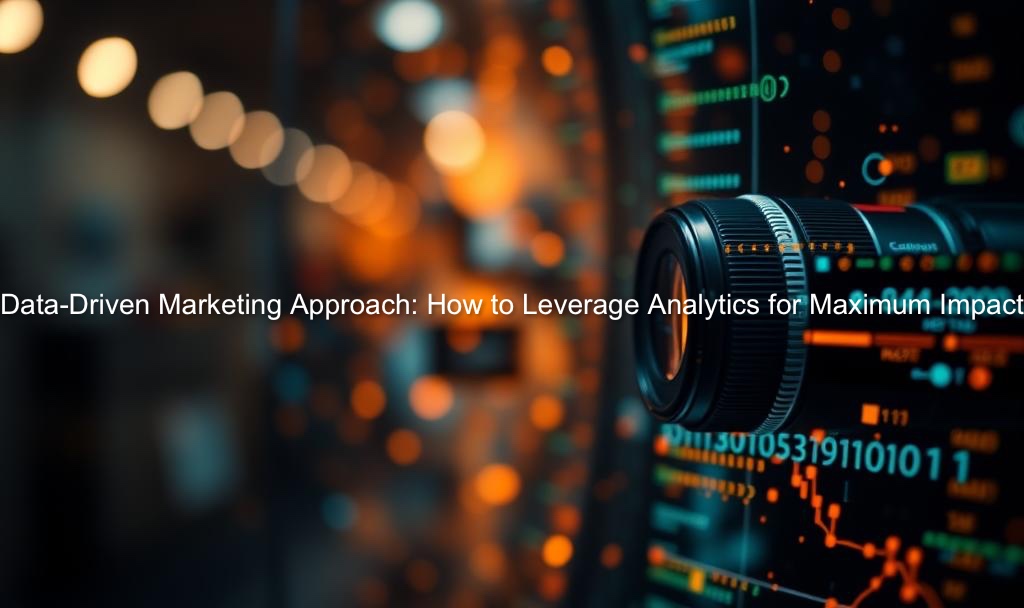In today’s hyper-competitive digital landscape, intuition alone is no longer enough to drive marketing success. Brands that rely on guesswork waste budgets, miss opportunities, and fall behind competitors. A data-driven marketing approach eliminates uncertainty by using real-time analytics, customer insights, and performance metrics to optimize campaigns, personalize messaging, and maximize ROI.
This guide will break down the key components of a data-driven marketing strategy, showcase real-world examples, and provide actionable steps to implement this methodology in your business. By the end, you’ll understand why data-driven decisions outperform traditional marketing—and how CliqSpot helps you stay ahead with the latest proven tactics.
—
Why a Data-Driven Marketing Approach Works
Data-driven marketing is the practice of making strategic decisions based on quantitative evidence rather than assumptions. According to a 2024 report by McKinsey, companies that leverage data-driven strategies achieve 5-8x higher ROI on marketing spend compared to those relying on intuition.
Key Benefits:
✅ Higher Conversion Rates – Optimizing campaigns based on real user behavior (e.g., A/B testing CTAs) can lift conversions by **20-40%** (HubSpot).
✅ Lower Customer Acquisition Costs (CAC) – Targeting high-intent audiences reduces wasted ad spend.
✅ Improved Customer Retention – Personalized messaging (based on past interactions) increases repeat purchases by **35%** (Salesforce).
✅ Faster Decision-Making – Real-time dashboards replace slow, opinion-based debates.
—
4 Pillars of a Data-Driven Marketing Approach
1. Audience Segmentation & Personalization
Instead of blasting generic messages, top marketers use behavioral data to segment audiences and tailor content.
Example:
– Netflix uses viewing history to recommend shows, driving 80% of watched content from its recommendation engine.
– Spotify’s “Wrapped” campaign personalizes yearly listening stats, generating social virality and 21% higher engagement.
How to Implement:
– Use Google Analytics 4 (GA4) to track user behavior.
– Deploy email segmentation (e.g., Klaviyo) to send targeted offers.
2. Predictive Analytics & AI
Machine learning models predict future customer actions, allowing marketers to preemptively adjust strategies.
Example:
– Amazon’s anticipatory shipping uses past purchase data to pre-position products near likely buyers, cutting delivery times.
– Starbucks’ rewards app predicts when users are most likely to buy, sending personalized discounts at peak times.
How to Implement:
– Tools like Google’s Predictive Analytics or IBM Watson help forecast trends.
3. A/B Testing & Continuous Optimization
Data-driven marketers never assume—they test everything.
Example:
– Airbnb increased bookings by 30% simply by testing different hero images on its homepage.
– The New York Times boosted subscriptions by 12% by tweaking its paywall messaging.
How to Implement:
– Use Optimizely or VWO for A/B testing.
– Test headlines, CTAs, images, and pricing models.
4. Attribution Modeling
Understanding which touchpoints drive conversions prevents wasted spend.
Example:
– Dollar Shave Club discovered YouTube ads were their top acquisition channel—doubling down led to 4x growth.
– B2B brands using multi-touch attribution reduce CAC by 22% (Demandbase).
How to Implement:
– Google Ads’ Data-Driven Attribution assigns credit to each interaction.
– HubSpot’s Campaign Analytics tracks cross-channel impact.
—
3 Real-World Success Stories
1. How Sephora Increased Sales by 35% with Data
– Used purchase history + AI to recommend products.
– Sent personalized birthday discounts, lifting redemption rates.
2. How Nike Reduced Ad Waste by 50%
– Leveraged first-party data to retarget high-value customers.
– Cut underperforming ad placements using real-time dashboards.
3. How Slack Scaled with Hyper-Targeted LinkedIn Ads
– Analyzed firmographic data to target tech decision-makers.
– Achieved a 7x lower CAC than industry benchmarks.
—
How to Start Using a Data-Driven Marketing Approach
1. Audit Your Current Data – Identify gaps in tracking (e.g., missing UTM tags).
2. Set Clear KPIs – Focus on conversion rates, CAC, and CLV.
3. Invest in the Right Tools – Google Analytics, Hotjar, CRM platforms.
4. Test Relentlessly – Even small tweaks (e.g., button color) can have big impacts.
5. Scale What Works – Double down on high-performing channels.
—
Why Subscribe to CliqSpot?
At CliqSpot, we cut through the noise and deliver only data-proven strategies—no fluff, just what’s working now.
Join our community of elite marketers to get:
Exclusive case studies (like the ones above)
Real-time benchmarks (CTR, CAC, ROI by industry)
Swipe-worthy templates (ads, emails, landing pages)
First access to tools & trends
Subscribe to CliqSpot – Your shortcut to data-driven marketing mastery.
—
Final Thought
In marketing, data don’t lie—but opinions do. The brands that win are those that let analytics guide every decision. Start small, measure relentlessly, and scale fast.
Want more? Reply with your biggest data challenge—we’ll cover it in a future article.

Data-driven editor at CliqSpot, transforming raw analytics into actionable growth strategies for modern businesses.

Leave a Reply